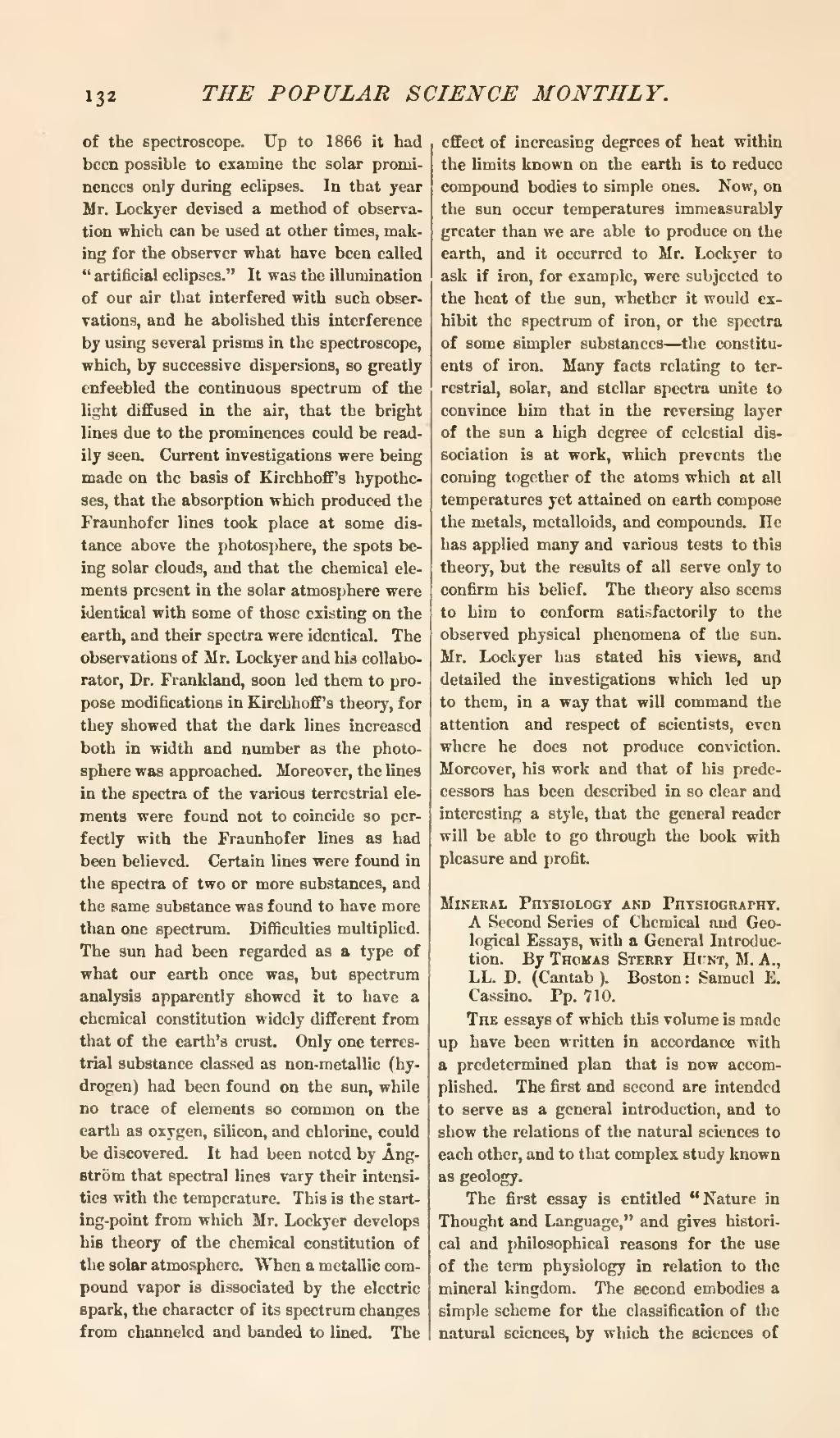of the spectroscope. Up to 1866 it had been possible to examine the solar prominences only during eclipses. In that year Mr. Lockyer devised a method of observation which can be used at other times, making for the observer what have been called "artificial eclipses." It was the illumination of our air that interfered with such observations, and he abolished this interference by using several prisms in the spectroscope, which, by successive dispersions, so greatly enfeebled the continuous spectrum of the light diffused in the air, that the bright lines due to the prominences could be readily seen. Current investigations were being made on the basis of Kirchhoff's hypotheses, that the absorption which produced the Fraunhofer lines took place at some distance above the photosphere, the spots being solar clouds, and that the chemical elements present in the solar atmosphere were identical with some of those existing on the earth, and their spectra were identical. The observations of Mr. Lockyer and his collaborator, Dr. Frankland, soon led them to propose modifications in Kirchhoff's theory, for they showed that the dark lines increased both in width and number as the photosphere was approached. Moreover, the lines in the spectra of the various terrestrial elements were found not to coincide so perfectly with the Fraunhofer lines as had been believed. Certain lines were found in the spectra of two or more substances, and the same substance was found to have more than one spectrum. Difficulties multiplied. The sun had been regarded as a type of what our earth once was, but spectrum analysis apparently showed it to have a chemical constitution widely different from that of the earth's crust. Only one terrestrial substance classed as non-metallic (hydrogen) had been found on the sun, while no trace of elements so common on the earth as oxygen, silicon, and chlorine, could be discovered. It had been noted by Ångström that spectral lines vary their intensities with the temperature. This is the starting-point from which Mr. Lockyer develops his theory of the chemical constitution of the solar atmosphere. When a metallic compound vapor is dissociated by the electric spark, the character of its spectrum changes from channeled and banded to lined. The effect of increasing degrees of heat within the limits known on the earth is to reduce compound bodies to simple ones. Now, on the sun occur temperatures immeasurably greater than we are able to produce on the earth, and it occurred to Mr. Lockyer to ask if iron, for example, were subjected to the heat of the sun, whether it would exhibit the spectrum of iron, or the spectra of some simpler substances—the constituents of iron. Many facts relating to terrestrial, solar, and stellar spectra unite to convince him that in the reversing layer of the sun a high degree of celestial dissociation is at work, which prevents the coming together of the atoms which at all temperatures yet attained on earth compose the metals, metalloids, and compounds. He has applied many and various tests to this theory, but the results of all serve only to confirm his belief. The theory also seems to him to conform satisfactorily to the observed physical phenomena of the sun. Mr. Lockyer has stated his views, and detailed the investigations which led up to them, in a way that will command the attention and respect of scientists, even where he does not produce conviction. Moreover, his work and that of his predecessors has been described in so clear and interesting a style, that the general reader will be able to go through the book with pleasure and profit.
Mineral Physiology and Physiography. A Second Series of Chemical and Geological Essays, with a General Introduction. By Thomas Sterry Bunt, M. A., LL. D. (Cantab.). Boston: Samuel E. Cassino. Pp. 710.
The essays of which this volume is made up have been written in accordance with a predetermined plan that is now accomplished. The first and second are intended to serve as a general introduction, and to show the relations of the natural sciences to each other, and to that complex study known as geology.
The first essay is entitled "Nature in Thought and Language," and gives historical and philosophical reasons for the use of the term physiology in relation to the mineral kingdom. The second embodies a simple scheme for the classification of the natural sciences, by which the sciences of
